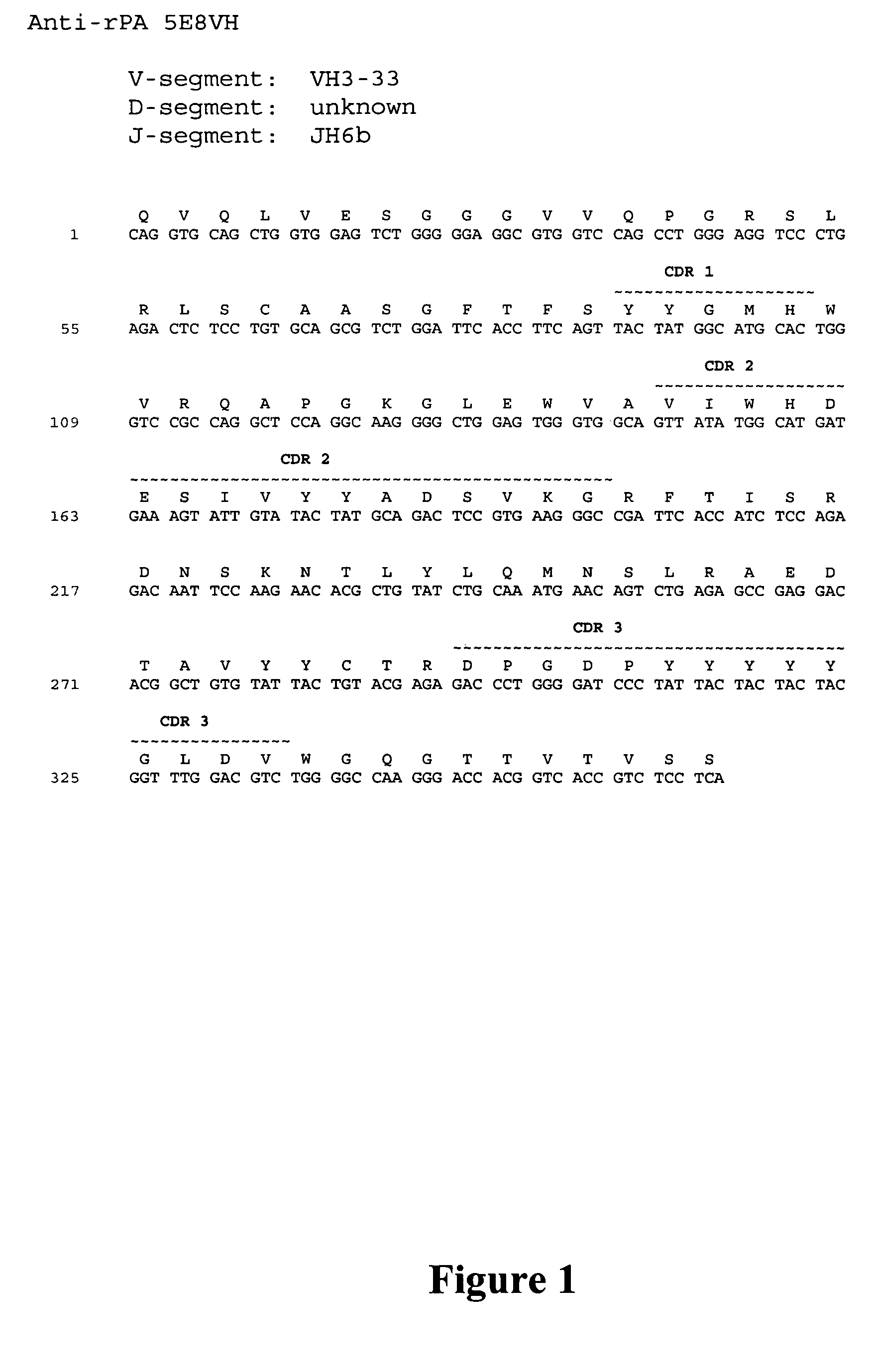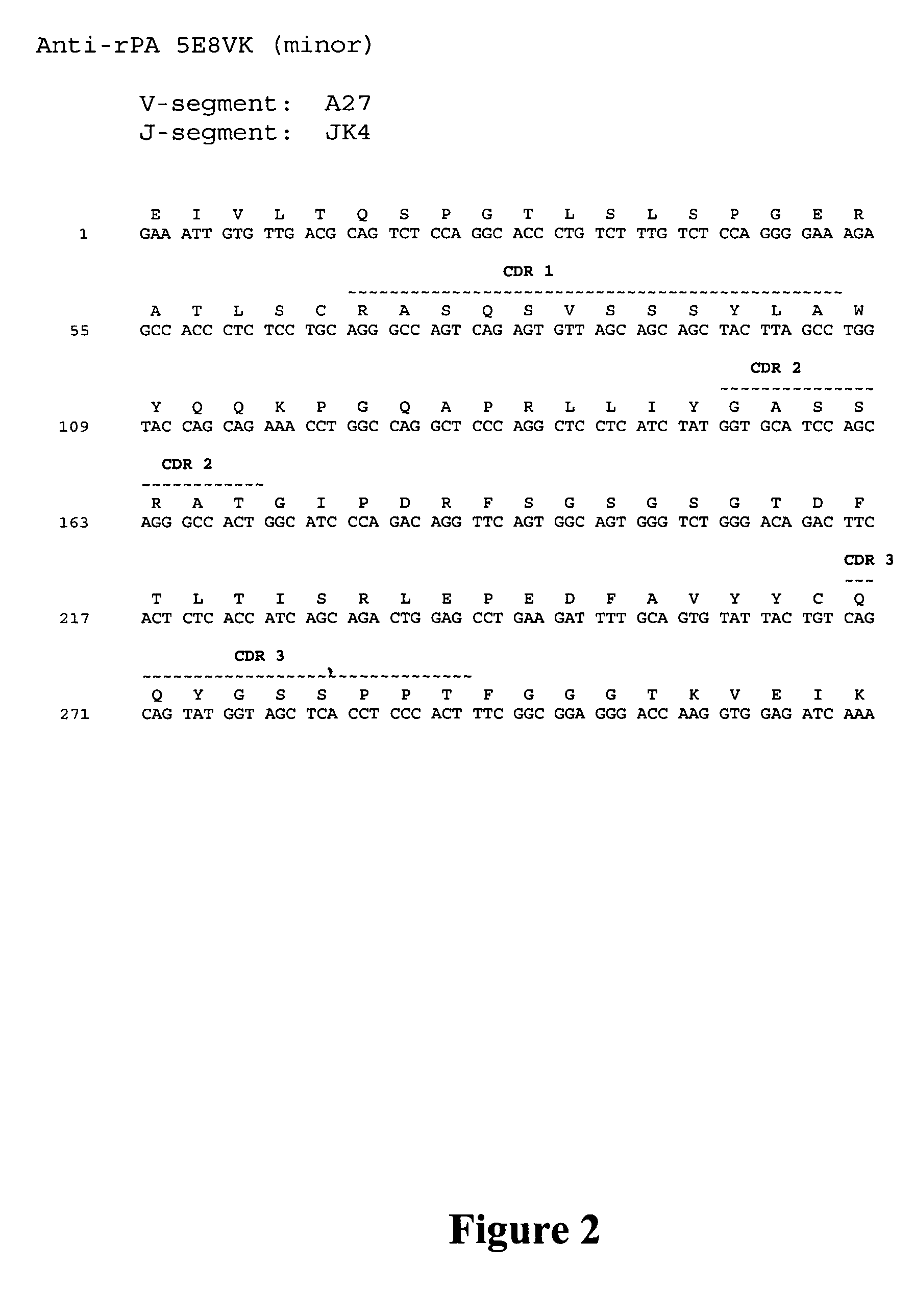Human monoclonal antibodies against Bacillus anthracis protective antigen
a technology of monoclonal antibodies and bacillus anthracis, which is applied in the field of human monoclonal antibodies against bacillus anthracis protective antigen, can solve the problems of posing a very real threat from bioterrorism, affecting the survival rate of sudden catastrophic illness, and affecting the survival rate of bacillus anthracis, so as to achieve less immunogenicity, less immunogenicity, and effective neutralizing protective antigen activity
- Summary
- Abstract
- Description
- Claims
- Application Information
AI Technical Summary
Benefits of technology
Problems solved by technology
Method used
Image
Examples
example 1
Preparation of Transgenic Animals which Express Fully Human Antibodies
I. Generation of Transgenic (Cmu Targeted) Mice
Construction of a CMD Targeting Vector
[0208]The plasmid pICEmu contains an EcoRI / XhoI fragment of the murine Ig heavy chain locus, spanning the mu gene, that was obtained from a Balb / C genomic lambda phage library (Marcu et al. Cell 22: 187, 1980). This genomic fragment was subcloned into the XhoI / EcoRI sites of the plasmid pICEMI9H (Marsh et al; Gene 32, 481-485, 1984). The heavy chain sequences included in pICEmu extend downstream of the EcoRI site located just 3′ of the mu intronic enhancer, to the XhoI site located approximately 1 kb downstream of the last transmembrane exon of the mu gene; however, much of the mu switch repeat region has been deleted by passage in E. coli.
[0209]The targeting vector was constructed as follows. A 1.3 kb HindIII / SmaI fragment was excised from pICEmu and subcloned into HindIII / SmaI digested pBluescript (Stratagene, La Jolla, Calif.)...
example 2
Production of Fully Human Antibodies Against Anthrax Protective Antigen
[0218]Human monoclonal antibodies against anthrax protective antigen were produced as described below in transgenic mice generated as described supra.
Generation of Human Anti-PA Monoclonal Antibodies
[0219]Transgenic HuMAb Mouse®, strain HC2 / KCo7, having four distinct genetic modifications was used for immunizations. These transgenic mice contain a human immunoglobulin gene miniloci that encodes unrearranged human heavy (μ and γ) and κ light chain immunoglobulin sequences, together with targeted mutations that inactivate the endogenous μ and κ chain loci. Accordingly, the mice exhibit no expression of mouse IgM or κ, and in response to immunization, the introduced human heavy and light chain transgenes undergo class switching and somatic mutation to generate high affinity human IgGκ monoclonal antibodies.
[0220]Mice were housed in filter cages and were evaluated to be in good physical condition on the dates of immu...
example 3a
In Vitro Neutralization of Lethal Toxin by Anti-PA Human Monoclonal Antibodies
[0226]TNA experiments were performed according to Little et al, 1990, supra. Briefly, the toxin-sensitive murine macrophage cell line J774A. 1 was exposed to a mixture of PA and LF (10:1) in the presence or absence of varying concentrations of anti-PA mAbs. After a 3 hour incubation, survival of the macrophages was determined using a viability dye (MTT). The results (FIG. 10) demonstrate the activity of the human anti-PA antibodies to neutralize lethal toxin in vitro. The following Table 2 indicates the effective dose of antibody required to maintain 50% viability (ED50) of macrophages in the TNA.
[0227]
TABLE 2ED50Antibody(μg / mL)5D50.0352H40.0605E80.0152D55
[0228]To test for direct binding to anthrax protective antigen, ELISA plates were coated with PA83 or PA63. The mAb samples were added at appropriate dilutions, and bound antibody was detected with anti-human IgG alkaline phophatase-conjugated probes. The...
PUM
| Property | Measurement | Unit |
|---|---|---|
| concentrations | aaaaa | aaaaa |
| concentrations | aaaaa | aaaaa |
| concentrations | aaaaa | aaaaa |
Abstract
Description
Claims
Application Information
 Login to View More
Login to View More - R&D
- Intellectual Property
- Life Sciences
- Materials
- Tech Scout
- Unparalleled Data Quality
- Higher Quality Content
- 60% Fewer Hallucinations
Browse by: Latest US Patents, China's latest patents, Technical Efficacy Thesaurus, Application Domain, Technology Topic, Popular Technical Reports.
© 2025 PatSnap. All rights reserved.Legal|Privacy policy|Modern Slavery Act Transparency Statement|Sitemap|About US| Contact US: help@patsnap.com



